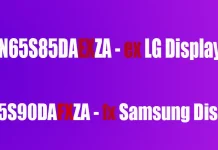Buying a new TV can be confusing these days. As there are a lot of complicated terms, it may be a bit difficult to understand the differences between the models. If you have ever sought a TV, you might have seen the term “refresh rate.” To make it simpler, the information below will make everything clear about the refresh rate and which one is the best for watching movies, playing video games, and more.
What is Refresh Rate
Refresh rate shows how many times the image on a TV screen can be updated or “refreshed” every second. Handling motion is better on TVs which have faster refresh rates, especially when watching action movies or playing video games.
Refresh rate is measured in Hertz (Hz), which is a frequency. For example, a 60Hz TV can refresh the screen 60 times per second, while a 120Hz TV can refresh the screen 120 times per second. However, TVs with faster refresh rates aren’t necessarily better at handling motion.
What differences between 60Hz vs 120Hz
If you’re thinking about a new TV these days, it will have a refresh rate of either 60Hz or 120Hz. While they will both look identical when watching TV shows filmed at 30fps, TVs with a faster refresh rate are generally better at handling motion when watching movies filmed at 24fps.
If you want to match your refresh rate with a video’s frame rate, your TV will display each frame multiple times. For example, if you’re watching a TV show filmed at 30fps on a 60Hz TV, each frame will be doubled and played for half as long.
That same video will look identical on a 120Hz TV since the TV will just display each frame four times and play them a quarter as long.
However, if you want to watch a movie on a 60Hz TV, you may face one issue. This is because most movies are shot at 24 fps, which isn’t a good divisible of 60. So, a 60Hz TV uses a method called “3:2 pulldown” to make the frame rate match the refresh rate. To do this, one frame will be displayed twice and then the next frame three times.
Since the video displays some frames longer than others, you might experience “judder” when watching movies on a 60Hz TV. This effect will make motion look jerky, and it can also cause the video to play slightly slower than it should.
On the other hand, if you’re watching a movie on a 120Hz TV, each frame can be displayed five times, which means that the look of the movie which the filmmaker intended will be retained. And while there isn’t much 120fps content, some movies and videos games do use the high frame rate.
What is the best Refresh Rate for TVs
Every modern TV has a refresh rate of either 60Hz or 120Hz. While 60Hz TVs are good enough for watching almost any videos without any problem, if you want to watch movies and play video games, better go to 120Hz TVs.
The only problem is that most TVs still have HDMI 2.0 inputs, which limits your video sources to a refresh rate of 60Hz. If you want to take full advantage of a 120Hz TV, make sure to look for a model with an HDMI 2.1 port, especially if you have a next-generation gaming console.
What is a the best Refresh Rate for a gaming TV
If you have an older console, 60Hz will be enough for a gaming TV. However, the Xbox One S/X, Xbox Series X, and PS5 all support 120Hz, so the motion will look better on TVs with a faster refresh rate. Just make sure that your TV has the HDMI 2.1 port.
In addition, if you want a TV that supports VRR (variable refresh rate), this feature will sync the refresh rate of your TV and the frame rate of your game in real-time. So, if the frame rate of your game drops, your TV will automatically switch to a lower refresh rate.
So, all in all, this isn’t as complicated as you may think. Hope, that this article made it clear about the Refresh Rate.






